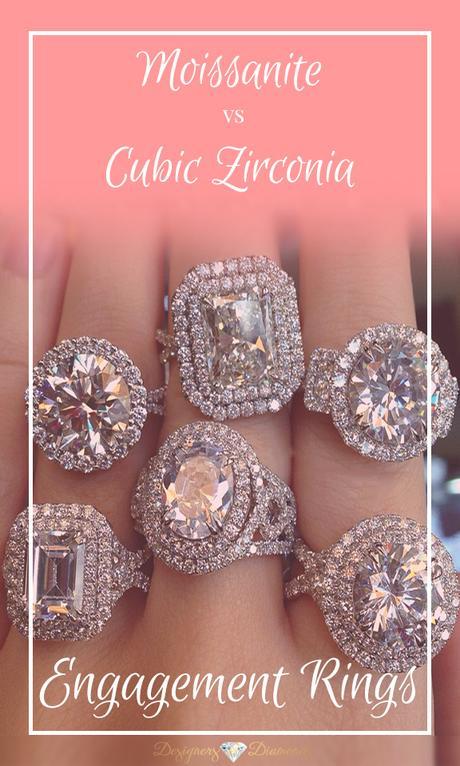Let’s chat simulants! If that word sounds sterile I apologize. Obviously nothing can evoke the same warm fuzzies like the word “diamond” can, but I bear no ill will toward these affordable alternative center stone options.
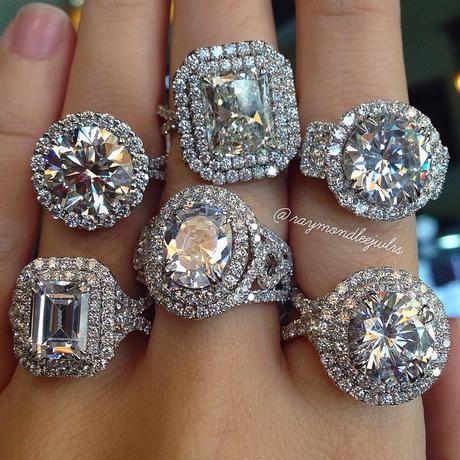
Which are CZ’s and which are Moissanite? Trick question, these are diamonds ;)
Moissanite vs Cubic Zirconia
Moissanite and cubic zirconia both stand-in for diamonds for those who don’t want the carbon. Perhaps for reasons relating to:
- Pricing (these two alternatives cost much less than diamonds)
- Sustainability (even recycled diamonds just don’t sit right with some people. They prefer these man-made options that guarantee eco-friendliness and present zero ethical gray area.)
- Responsibility (you can only lose so many mates to your diamond studs before you admit that maybe you have a problem.)
But the two are not interchangeable! Let’s talk about Moissanite vs cubic zirconia.
Related: How an Engagement Ring is Made
Moissanite
This naturally occurring gem was first discovered in 1893 by French scientist Henri Moissan, hence the name. Henri discovered a glittering meteorite crater in Arizona, thinking he’d struck diamonds. He figured out quickly though that the gems were actually made of silicon carbide rather than straight carbon. Obviously, we don’t all have a French scientist on staff to find the latest and greatest meteorite crash sites, so natural Moissanite is exceptionally rare. Most of the Moissanite used in jewelry today is lab created, thanks to Henri Moissan’s development of those meteorite particles into an easily replicated diamond simulant.
Moissanite vs. Diamond

Top: Moissanite Bottom: Diamond
The two couldn’t be more different, even though Moissanite mimics a diamond by design. How they differ:
- Hardness – a Moissanite scores an impressive 9.25 on the Mohs scale. A diamond, of course, is a perfect 10. But that 9.25 still earns Moissanite a spot in the hardness hall of fame and makes it a great option for everyday wear.
- Brilliance – The faceting pattern for each stone makes the biggest difference in their appearance. A Moissanite is actually more brilliant than a diamond, with more rainbow flashes of light and a more glittery appearance. Some people are into this, some are decidedly not. A diamond’s facets give it not only brilliance, but also fire and scintillation (different ways that it reflects and refracts light.) A diamond will have slightly less colorful flashes, and more black and white (scintillation.)
- Color – Moissanite appears warmer, with a yellow or gray tinge to even the colorless stones. Think a GIA H/I color. A diamond can score anywhere from a D colorless grade to a Z light yellow on the normal color grading scale.
- Price – Moissanite differs from diamond pricing structure (duh.) Moissanites are measured in millimeters, where diamonds are measured in carat weight. You can’t compare the two carat weights because their different chemical makeup gives them very different weights. So a 1 carat diamond would be most similar to a 6.5mm Moissanite. That being said, there’s no price-per-carat structure for Moissanite like there is for diamond pricing. Moissanite is much less expensive, costing a fraction of a diamond with similar diameter. Like $5k vs. $700. Big difference.
Moissanite Pro Tips
Decided a Moissanite is for you? Here’s how to make sure it looks as close to a diamond as you want it to:
- Round brilliant is the way to go. All those facets hide the color of a Moissanite nicely and will also disguise any scratches it might get over time.
- If you insist on a fancy shape, don’t get an emerald cut. For the exact reason above, those minimalist facets don’t leave much hiding space for color or any other non-diamond-like behavior.
- Stay under 2 carats. The larger the Moissanite, the more obvious it becomes that it’s not a diamond.
Related: How Much Does This Ring Cost?
Cubic Zirconia
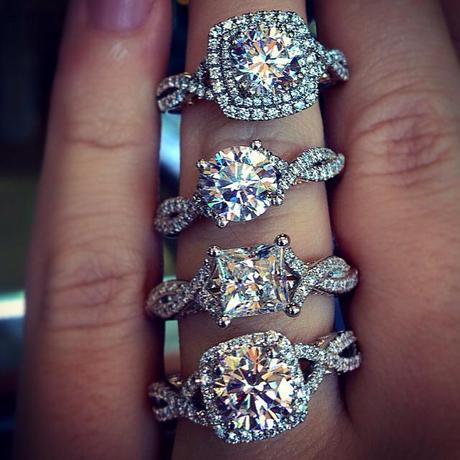
The CZ is the most famous diamond simulant. However, unlike Moissanite, it isn’t a great substitute for the real deal – at least not in certain pieces of jewelry, like your engagement ring. CZ’s have been a diamond’s main competition since 1976, thanks to their low cost of production and – at first glance – similarity to a diamond. However, unlike a diamond they are not a natural gem, they’re lab-created. They are also not related to Zircon, a naturally occurring gemstone. Let’s dive into the nitty gritty.
Cubic Zirconia vs. Diamonds
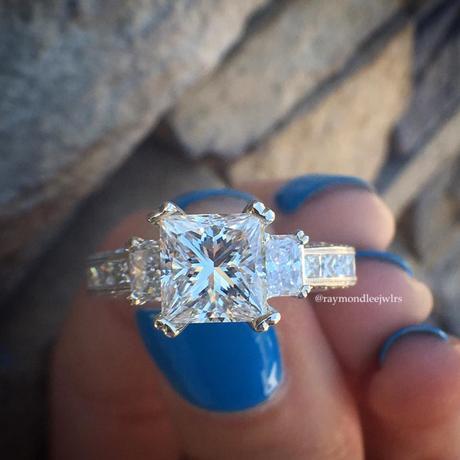
This Tacori ring is set with a 1.71ct princess cut diamond
- Hardness – A CZ is nowhere near as hard as a diamond. You might think it is, since it scores an 8 on the Mohs scale. But that doesn’t mean it’s graded the same way your term papers were – it’s not 10% less hard than a 9. Rather, it means that any substance that scores higher than an 8 will scratch it. And you’d be surprised how many “substances” that includes. CZ’s scratch very easily, looking cloudy and, um, scratchy, in short measure. A diamond, again, is a perfect 10.
- Brilliance – a CZ is less brilliant than a diamond (it has a lower refractive index, and doesn’t capture light as well) however it has more fire. It, like Moissanite, will look more colorful when it’s flashing around and doing its thing. I’ll also make a note here about the facet pattern – it looks a little too perfect. When you inspect a CZ, the facets might look almost pixellated, and just too perfectly geometric. Cubic, actually.
- Color – CZ’s are as colorless as a D GIA grade diamond, but they can be made in any color of the rainbow. They do tend to have a bluish cast to them.
- Price – A CZ is much cheaper than a diamond with the same diameter. Again, carats won’t work here because you’re comparing two stones of entirely different density. A CZ is heavier. But that $5000 one carat diamond shouldn’t cost you more than $30 as a CZ.
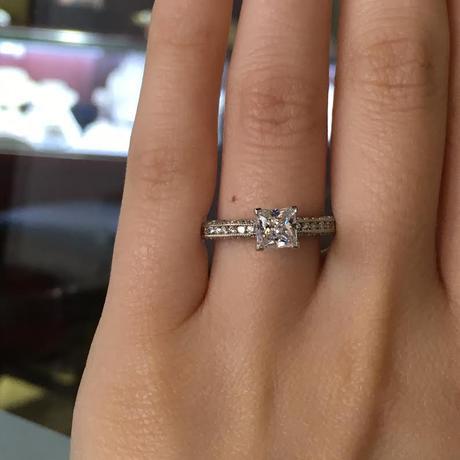
And here a similar Tacori setting shown with a princess cut CZ
What’s not to love at that price?! Well, don’t get too excited. There are a few pro-tips when considering a CZ.
- Keep it under 2 “carats”, around 8.2mm – anything larger will be glaringly obvious that it’s not a diamond, especially in an engagement ring. The designer settings at DBRL come locked and loaded with CZ’S, and one designer we no longer carry used to set their semi-mounts with huge 3 carat-ish CZ’s. They looked exceedingly goofy.
- Prepare yourself for replacements – you’ll need to replace your CZ every few years or even more often depending on how often you wear it. Factor in the cost of swapping the stone and the wear and tear it will have on your setting(s). Yes, this replacing and labor and even the cost of new prongs will still be significantly less than a diamond over the course of your jewelry’s lifetime.
- Keep it cocktail – CZ’s are GREAT options for trendier pieces and fashion-y cocktail pieces. And earrings. Not necessarily for your engagement ring. Because they get banged up so easily, CZ’s don’t look pretty as a center stone for very long. And with a precious setting like your engagement ring any wear and tear on the setting and prongs comes with a high cost, both emotional and financial.
Related: Want to Finance Engagement Ring Dreams? Here’s How.
So, to recap. If you’re exploring diamond alternatives, Moissanite is the better bet for a piece you wear every day. If the bottom line is your bottom line, a CZ is your cheaper option. You just have to factor in the hidden costs.
If you want to see CZ’s in action, look no further than Diamonds by Raymond Lee on Pinterest. 99.9% of our rings have CZ placeholders when they arrive from the designers’ HQ. And if you have any questions about diamond simulants just ask me in the comments!
